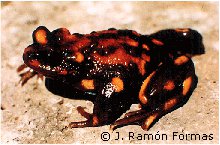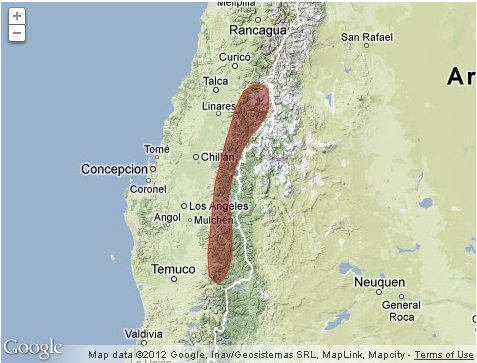
The Calyptocephalellidae only contains three other species (Bullock’s false toad – EDGE amphibian number 5, the Pelado Mountains false toad, and the helmeted water toad), all of which are threatened or worse.
The Chile Mountains false toad can reach 70 mm as an adult, and it has beautiful black, orange and yellow colouration. Little is known about its biology: after it was formally discovered in 1899 it wasn’t seen for 100 years, even then it was only seen in just three places. However, we can predict a lot of its characteristics by comparing it to its closest top 100 EDGE amphibian relative, Bullock’s false toad. The Chile Mountains false toad probably reproduce in the same way as its cousin, breeding in streams where its eggs hatch into tadpoles that develop by scraping algae from rock, and feeding on ground-dwelling invertebrates.

Occurring on the western slopes of the Chilean Andes (Altos de Vilches, Talca Province; Cordillera de Chillan, Chillan Province; and Ralco, Bio Bio Province) the Chile Mountains false toad enjoys high altitudes; living up to 1,700 metres above sea level, but the overall area it actually inhabits is less than 500 sq km. We know that it exists under rocks along streams in temperate forest, but there is not enough data to show whether or not it can survive environmental changes.
The Chile Mountains false toad is listed as Endangered in the IUCN Red List because its habitat is disappearing quickly, plus the fact it only occurs in three known places. Forest fires, alien vegetation species such as pine and eucalyptus plantations, and its limited distribution across fragmented populations are all factors contributing to its decline.
Help EDGE implement sustainable conservation programmes for species like the Chile Mountains false toad by donating today. Every little bit of funding brings us closer towards our goal of having a fully-functioning programme for all EDGE species…
…and we are still running the pygmy sloth campaign! Get involved here >